Carnival Magic arrived on schedule at the port of Key West, Florida, around 9 a.m. Tuesday. Our excursion was a city view trolley tour that included admission to the Key West Butterfly and Nature Conservatory. It sounded like it would just be something to do – we weren’t attracted to any of the beachy activities, especially especially when there was such a cool, brisk wind.
Key West is an island about four miles long and only two miles wide. At the end of our pier stood the old Customs House, a large red brick building now used as a museum. The temperature was in the mid to upper 60s, but a light jacket felt good. We learned that the historical temperature range on the island is from 42 to 97 degrees, and it averages about 77 year round. We heard several locals commenting on this “cold winter day.”
We gathered on the pier and were herded onto a trolley-style, open-air bus. Our guide was Jim, a Boston transplant, complete with the accent and a Red Sox cap. His sense of humor was one of the highlights of our day, as he kept us laughing while he pointed out various sites and filled in all sorts of historical detail.
He drove us past Fort Zachary Taylor Historical Park and the Truman Annex Naval Base, now converted into a residential neighborhood of closely situated, small, wood frame houses, each valued between one and two million dollars! We passed by Higgs Beach, a man-made strip of shipped- and trucked-in sand, that, according to Jim, has to be shoveled off the nearby tennis courts after every storm. The sandy strip had to be created because the coral reef seven miles off shore inhibits the action of waves that otherwise would create a natural beach.
At the end of Duval Street, we stopped at the marker for the southernmost point, surrounded by the Southernmost Hotel and the Southernmost House. We learned that the designation referring to the “continental United States” happened only fairly recently (the 1940s, I think), when Key West was finally connected to the rest of the country by an automobile bridge. Prior to that they were just an offshore island.
Near the southernmost point was the butterfly conservatory. Inside its climate-controlled environment live different species of colorful butterflies, moths, and a surprising number of small birds, which we thought would enjoy eating the insects, but apparently they don’t. A couple of large birds also live there – a breeding pair of flamingos named Rhett and Scarlett, who somehow found their way to Key West from Toronto, in Canada.
Leaving the butterflies, Diane and I struck out on our own and walked to the Hemingway Home, a two-story residence constructed in 1933 for $8,000. Ernest Hemingway lived there with his third (I think) wife, who later added a $20,000 swimming pool on the property. The whole estate occupies about an acre, and is situated across the street from the Key West lighthouse, a beacon used by the writer to find his way home after long nights of drinking at Sloppy Joe’s Bar.
Ernest and Joe (nicknamed “Sloppy” by Hemingway) themselves built the brick wall surrounding the property, and, as our guide pointed out, “neither had any experience with masonry,” a fact that became obvious when we looked more closely at the wall. Our guide through the house was another displaced Bostonian, who said that Hemingway was excellent at two things – writing and drinking – and that when he wasn’t doing one, he was usually doing the other. “And,” he said, “when he built this wall, he wasn’t writing.”
After Fidel Castro came to power and after the botched Bay of Pigs invasion, Castro confiscated Hemingway’s beloved Cuban property, which resulted in the writer living for the rest of his life in his home in Idaho. In 1961 he succumbed to the tragic depression that plagued his family, and, like his father had done and his daughter would later do, took his own life.
Forty or fifty cats live on the property of the Hemingway home, direct descendants of his initial breeding pair. They’re famous for being polydactyl, that is, having multiple toes (six, in most cases), a source of fascination to Hemingway. As we first walked toward the property, we passed a couple of tourist women kneeling at one of the gates and focusing on a cat just inside. “Look,” one of them said. “I think it’s one of those pterodactyls!”
We thoroughly enjoyed our day on Key West, thinking often about our friend George, who once was Key West bureau chief for the Miami Herald. I suspect many things have changed since those days, but the free-spirited nature of the “Conchs” remains the same. We learned that it is the City of Key West’s official philosophy to promote “unity and equality for all people worldwide” – an impressive belief that we wholeheartedly endorse.
Back on the ship, we lunched, napped, showered, and ate again. Carnival Magic departed Key West at 6 p.m., bound for Wednesday’s 7 a.m. arrival at Freeport, in the Bahamas.
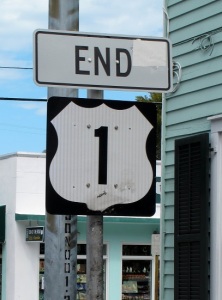
Key West is literally the end of the road. If you started in Maine driving south on U.S. Highway 1, this is where you’d end up.
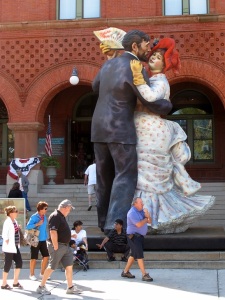
Larger-than-life statuary abounds in Key West. This one is in front of the old Customs House, now a museum.
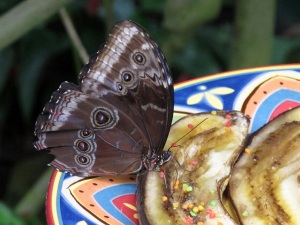
Want to attract butterflies? Put old bananas on a colorful plate, and add some festive sprinkles . . .
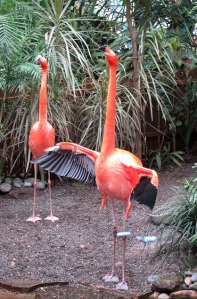
Rhett and Scarlett, the pair of flamingos that inhabit the butterfly conservatory. I think Rhett may be saying, “Frankly, my dear . . . “
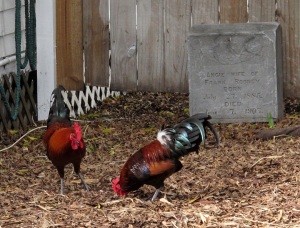
I shot this to illustrate the chickens that roam freely (and protected by law) around the island. These were scratching around in the side yard of a home, and I didn’t see the gravestone there till I edited the photos!

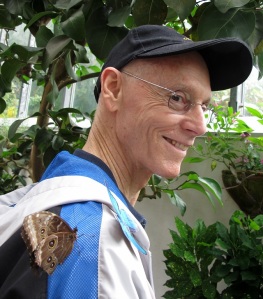
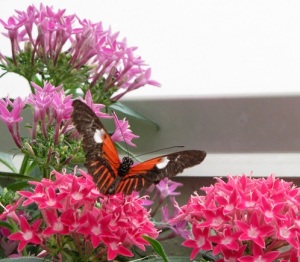
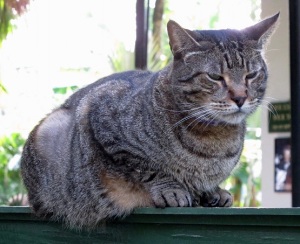
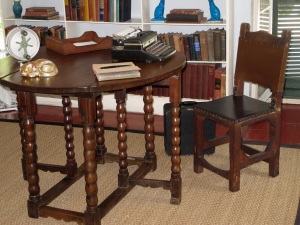
I served two years in the Navy in Key West and another two years at Key West bureau chief for The Miami Herald. I was in my 20s, newlywed and about has happy as I’ve ever been.
I laughed out loud two or three times. Too funny with the dinosaur cats.
What a fun time!
You are so clever with your titles! Of course, your writing is as wonderful as ever, and your photos a real treat! What fun! I lived in Florida for 20 years and only have visited Key West once when I took a cruise out of Galveston (after having moved to Texas)! It was Christmas Eve and hardly anything was open, but we did see the cats!
Love, Catherine
Sounds like a nice adventure exploring Key West, now I’ll be better prepared when I finally make it there! Keep on enjoying!!!